Growing lavender from seed can be difficult, especially for new gardeners. But once you know how, you will have much better success.
If you struggle with it, you are not alone. It requires some extra steps and lots of patience. In this post, I’ll show you everything you need to know.
Here you’ll learn all about when and how to grow lavender seeds. Including the best sowing techniques, step by step planting instructions, how long they take to germinate, seedling care tips, transplanting, and more.
Growing Lavender From Seed
| Days to germination | 14-30 days |
| When to start indoors | 10-12 weeks before transplanting |
| When to sow outside | 3-6 weeks before your last spring frost date |
| Days to maturity | 2nd year after germination |
| Sun exposure | Full sun to partial shade |
| Seed planting depth | 1/8” deep |
| Spacing | Groupings 2″ apart, then thin to 18-24″ |
| Soil temperature | 60-65°F |
Types To Grow
In general, there are three main types of lavender seeds you can grow: English, Spanish, or French. But these days, there are also some great hybrids to choose from.
A few of my favorites are Hidcote dwarf, Munstead, and Provence blue. The sowing instructions below will work no matter which type you choose.
Related Post: How To Collect Lavender Seeds From Your Garden
How Long From Seed To Harvest
When you grow lavender from seed, it takes at least a year for them to bloom to their full potential. They can flower lightly the first year, and you may be able to harvest a few buds from them.
But they should be fully mature by their second season, giving you tons of delicious smelling flowers to enjoy.
Related Post: How To Care For Lavender Plants

Tips For Planting Lavender Seeds
Successfully growing lavender seeds requires some special steps. They are cold hardy and need a bit of extra help to germinate. Below I’ll show you exactly what to do before planting them, and the best method to use.
Lavender Seed Starting Methods
There are 3 techniques you could use to grow lavender seeds: 1. starting them indoors, 2. direct planting, 3. winter sowing. So experiment to see which one works for you.
- Starting indoors (best method) – The best way to grow lavender from seed is to start them indoors. They can take a long time to germinate, and tend to sprout unevenly, so keeping them inside in a controlled environment will give you the most consistent results.
- Direct planting – Of course, you could try planting them directly into your garden, I’ve had great success with mine. In this case, I recommend sowing them either in the fall or very early spring when it’s cold outside.
- Winter sowing – Since they need cold temps to germinate, they’re perfect for winter sowing. This way you’ll get the best of both worlds: you don’t have to take any extra steps to prepare them, and you won’t need to find room for them indoors.
Related Post: 3 Seed Starting Methods That Every Gardener Should Try
When To Start Lavender Seeds
Plant your lavender seeds indoors 10-12 weeks before your average last frost date. If you want to direct sow them, you should do that in very early spring, as soon as the ground is workable.
You could also try planting them in your garden in late fall, so they will sprout in the spring. Or winter sow them as soon as the outdoor temps stay below freezing in your area.
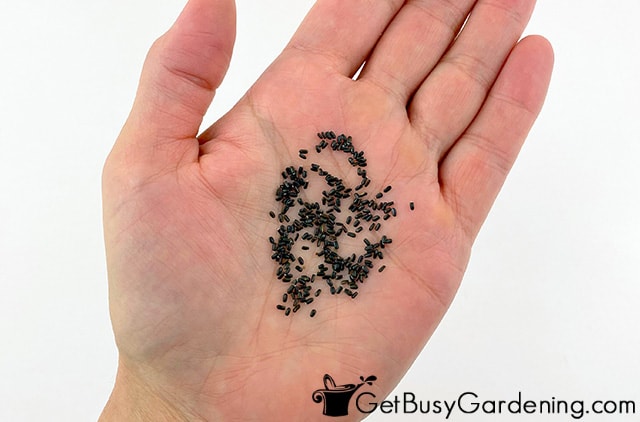
Preparing Lavender Seeds For Planting
Lavender seeds need a period of cool temperatures called “cold stratification” to germinate. If you skip this step, you may still have success. But most likely, you’ll see a very low germination rate.
The easiest way to cold stratify them is to place them in moist soil, then put them into the refrigerator for 3-6 weeks before planting.
Lavender Germination Time
Lavender seeds are extremely slow to germinate, and on average it can take anywhere from 14-21 days. Some are faster (2-3 weeks), but most can take a month or more to sprout, so be patient.
It’s also important to note that germination tends to be very uneven. You’ll probably notice that some will sprout faster than others. This is normal, so don’t give up on the slow pokes too soon.
What Do Lavender Seedlings Look Like?
The first two leaves that form right after germination are called the “seed leaves”. They are slightly oval shaped, and rounded on the ends.
All of the ones that grow after that are called the “true leaves”, and they look exactly like the mature leaves, only they are tiny.
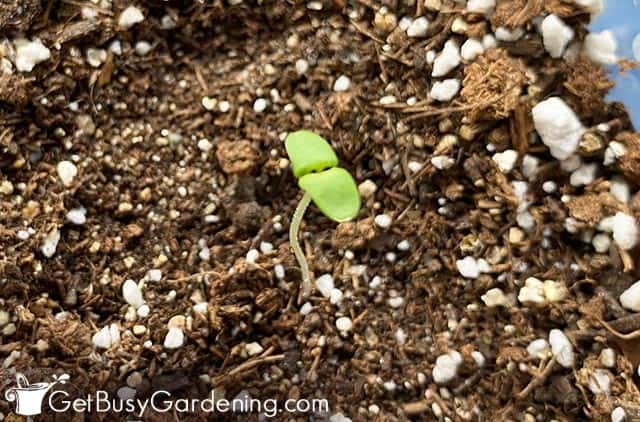
How To Care For Lavender Seedlings
Once your lavender seeds have sprouted, it’s important to give your seedlings the proper care so they will grow strong and healthy. Here are some tips for success:
Light
Lavender seeds need lots of light to germinate, and the seedlings can get leggy very quickly. A sunny window won’t provide enough, so you must supplement with artificial ones.
Hang your grow lights 1-2″ above the trays at all times. Use an outlet timer to make sure they get 14-16 hours of light every day.
Water
They need consistent water, but don’t like soggy or wet soil. So let it dry to the touch before moistening it again. I recommend using a moisture gauge to get it just right, and keep the reading between 3 and 5.

Fertilizer
Lavender prefers nutrient-poor soil, so you don’t need to worry about feeding your seedlings. In fact, too much fertilizer can stunt their growth and cause other problems. So you can skip it.
Potting Up
After they are twice the height of the tray, repot them into deeper containers. I like plantable pots, but you could certainly use reusable plastic ones if you prefer.
Transplanting
It’s best to wait until all chance of frost is gone before transplanting your lavender seedlings into the garden. They should be at least 2-3″ tall for the best results.
But, before you can do that, you must acclimate them to living outside. If you skip this step, then they probably won’t survive the move.
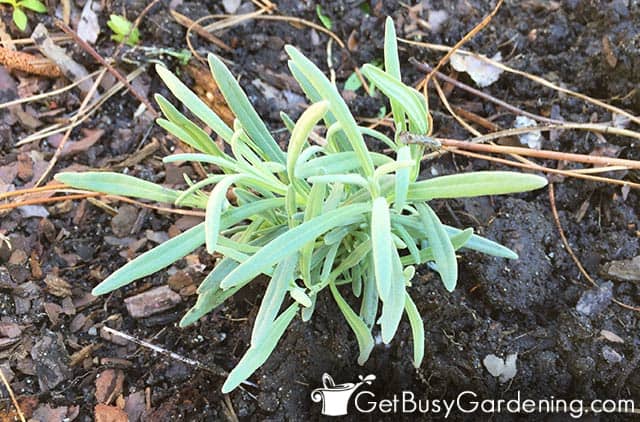
FAQs
Yes, lavender seeds need light to germinate, so do not plant them very deep. Just cover them lightly with soil, no more than 1/8 of an inch.
When lavender doesn’t germinate, it means the soil is too warm or wet, the seeds were planted too deep, they didn’t get enough light, or they were old and no longer viable. Give them plenty of light, make sure the soil stays between 60-65°F (using a thermometer probe), and that it’s only lightly moist.
Though it’s not absolutely required, I do recommend that you take the time to cold stratify your lavender seeds before planting them. Doing this will give you the best possible germination rate.
Growing lavender from seed can be tricky, but it’s incredibly rewarding. It takes time and patience, but having a bunch of seedlings to plant in your garden will make you feel great about your hard work.
If you’re tired of struggling, and want to learn how to grow any plant you want from seed, then enroll in my online Seed Starting Course. It’s a wonderful, fun, self-paced course that will teach you everything you need to know to easily grow your own seedlings. Enroll and get started today!
Or, if you just need a refresher, then my Starting Seeds Indoors eBook is for you! It’s a quick-start guide that will get you planting seeds in no time.
Share your tips for how to grow lavender from seeds in the comments section below.
Printable Step By Step Instructions
How To Grow Lavender From Seed
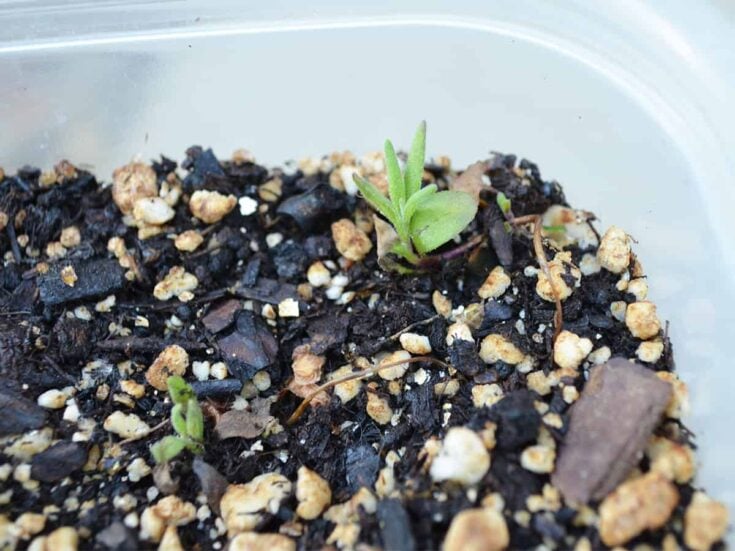
Growing lavender seeds takes a bit of planning and patience. To really set yourself up for success, gather all your supplies ahead of time, and follow these easy instructions.
Materials
Instructions
- Prepare the soil - Moisten the peat pellets before placing them into the seed trays, or fill the plastic cells with seed starting soil.
- Decide how many seeds to plant - Indoors, plant 2-3 lavender seeds per hole or pellet. Outside, space them in groupings about 2" apart, and thin them to 18-24" later.
- Plant the seeds - Drop the seeds on top of the soil. You can cover them with a thin layer of dirt, but make sure they aren't more than 1/8" deep because they need light to germinate.
- Water the soil - Add water the trays, rather than pouring it over the top, to avoid displacing the tiny seeds.
- Cover the trays - Put the plastic dome lid on top of the trays to keep the soil moist during germination.
- Give them plenty of light - Place the trays in a bright location, or turn on the grow lights. Remember, they need light to germinate, so give them plenty.
- Monitor the temperature - Keep the soil between 60-65°F degrees for the best germination rate. Use a soil thermometer to monitor the temperature.
Notes
- Lavender seeds need cold stratification for the best germination rate. Simply place them in moist soil, then put them into the refrigerator for 3-6 weeks before planting them.
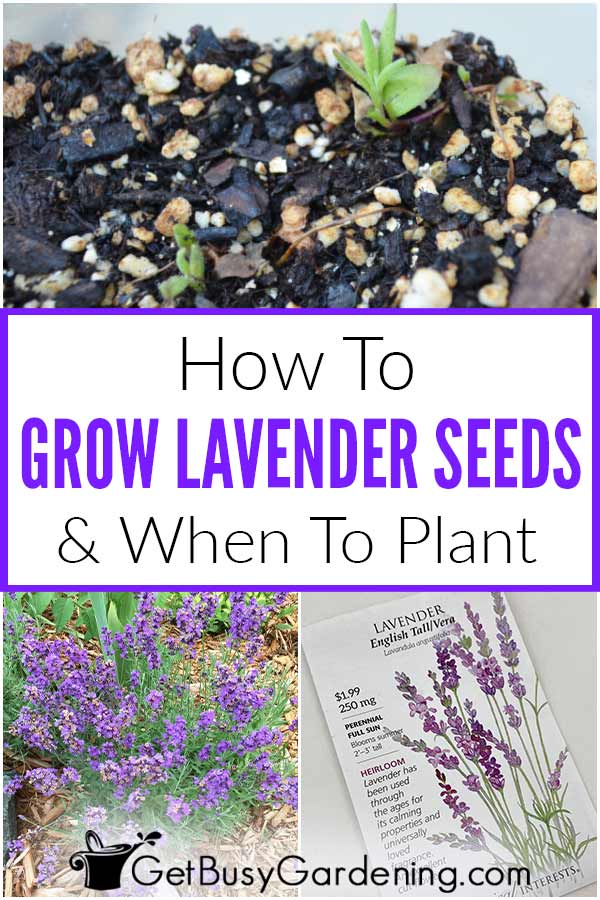
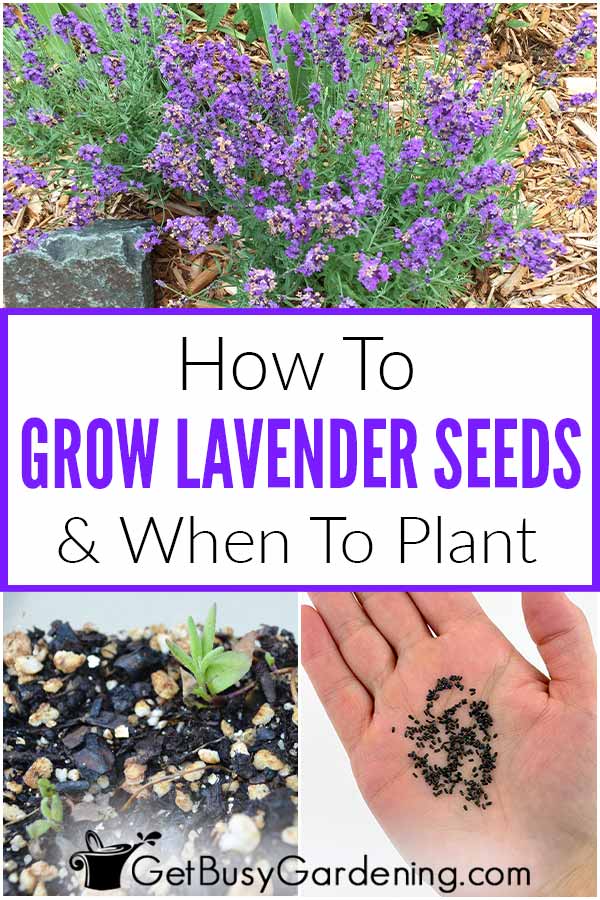
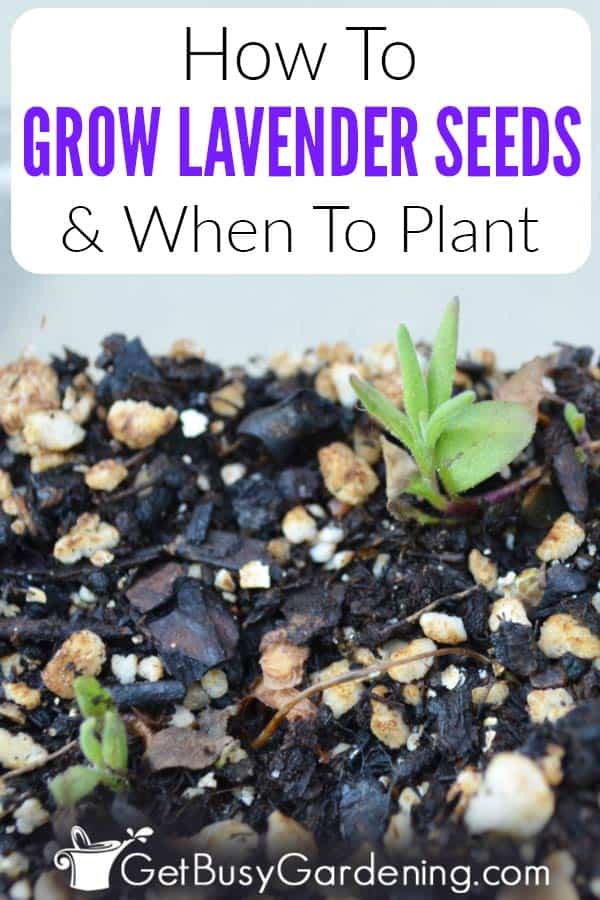
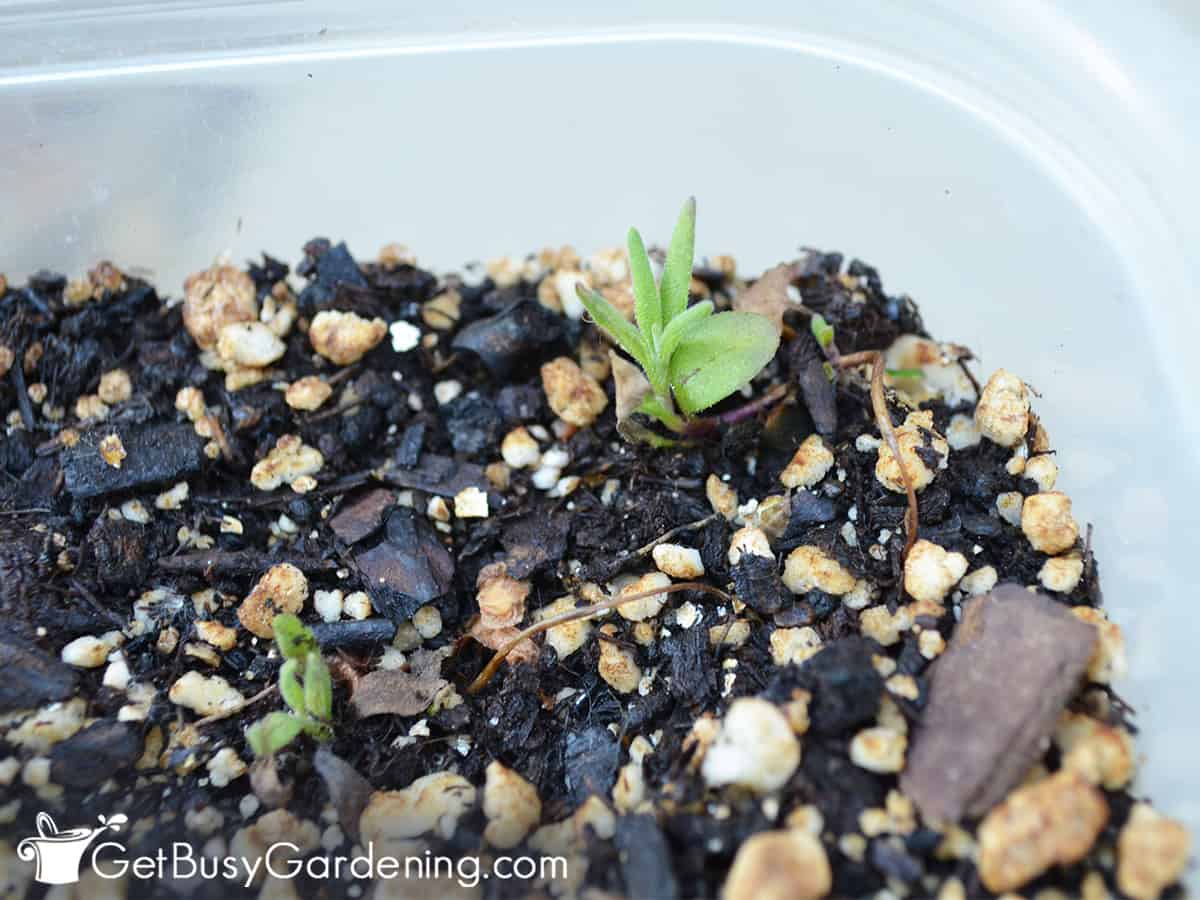

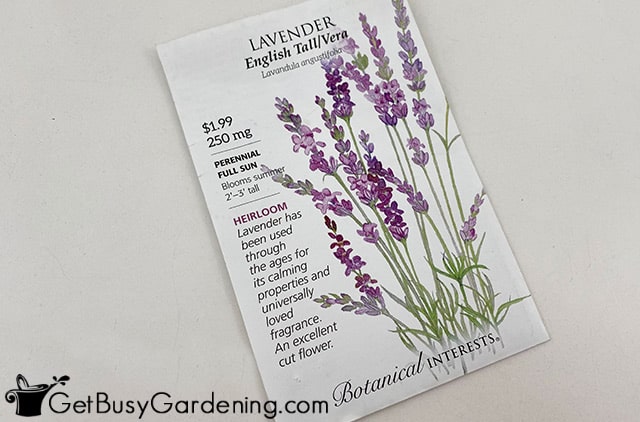


Lea Paradiso says
I am trying to grow lavender. For a year now. I planted about 20 in trays and I live in Arizona so it gets full sun and they grew to about centimeter and got like three to four of their true little Spike leaves and then stopped growing until about this summer and then they grew about to be 2 in and then died this August. I fertilized them I watered them properly and they got the full sun. They were just extremely slow growing and I tried transplanting it from one pot grabbing a huge dirt ball around it so I wouldn’t destroy the root system and it still died. I have one surviving out of 20 and it’s crispy. I want so desperately to save it because it’s taken a year for it to grow to 2 in. Help me!
Amy Andrychowicz says
The reason your lavender seedlings aren’t growing may be from too much fertilizer and/or the wrong type of soil. They like poor quality soils that are alkaline and don’t contain a lot of nutrients. So if your seedlings are in a nutrient-rich and/or acidic soil and/or you fertilize often, that may be why they’re struggling. Also, the sun in Arizona is much more intense than other parts of the country. So the full sun exposure may be too strong for the delicate seedlings. I would try giving them some protection from the sun during the afternoon to see if that helps. If you want to plant more lavender seeds, add some sand and/or perlite to the potting mix to improve the drainage, or you could even try germinating them in vermiculite or perlite alone to see if you have better success. Good luck!
Katherine says
I put my lavendar seeds in the fridge on a wet paper towel in a shallow plastic container with a lid. I left them in the firdge for about 6 months, possibly more than that. To my surprise I think just about every seed germinated. I now have roughly 400 seedlings growing strongly! My only issue is the huge number of pots and where to put them all. 😀
Amy Andrychowicz says
Haha, that’s a good problem to have! Thanks for sharing your wildly successful experience with growing your lavender seeds, that’s very cool!
GLYN says
Hi,
have no problem getting the lavender to start growing, but then they just get too long and leggy before I can transplant, not like the photo you have of a young plant, mine has about 2 inches of leggy growth with no leaves, just leaves on the top which makes it top heavy, any help would be grateful,
Amy Andrychowicz says
Lavender seedlings need a LOT of light in order to stay compact, otherwise they will get leggy like you describe. A sunny window isn’t enough, it’s best to have a grow light, hang it a few inches above the seedlings, and leave it on for 12-16 hours/day.
Mariana S. says
Are there different seed colors for different lavender types? I’ve seen only black lavender seeds online for stoechas and vera online, but I have lavandula dentata at home. I shook the seeds out of some flowers and they were a light beige like smaller sesame seeds.
I just want to know if there might be something wrong with my seeds and I’d be wasting my time trying to germinate them or if that is simply what dentata seeds like.
I live in a 9a hot and dry California climate and that species thrives and literally blooms year round on my front porch from scorching summer heat to light frost. I’d like to make more so I can share them.
Amy Andrychowicz says
Humm… I’m not sure if all types of lavender seeds are the same color. If they dropped out of the seed pods easily, then I would expect them to be viable. But you could perform a quick viability test to be sure, before you spend time planting them.
Mariana S. says
Okay, so I searched around and found a single picture of L. Dentata’s seeds next to the flowers and both look exactly like mine. Who knew?
So that said, do you know if they need stratification? They seem to be good for, at most, zones 8 to 10. With that range, there is no consistent winter frost or necessarily regular temperatures even in the 30s at night, let alone during the day. And so I wonder if it would make sense that it would be necessary for germination.
This is the first time I’ve had a garden somewhere cold enough in winter to kill a tropical plant. I was in previously 9b and 10 so this is all a bit new to me.
Amy Andrychowicz says
Cool, thanks so much for coming back and letting me know. Since they are a warm weather variety of lavender, then the seeds don’t need cold stratification in order to germinate. It certainly wouldn’t hurt to put them into your fridge for a few weeks if you want to experiment, but I wouldn’t try freezing them or they could die.
Lisa Widner says
Thank you for sharing your precise methods for growing lavender from seed, it will help me be successful.
Amy Andrychowicz says
You’re welcome, hope your lavender seeds will grow well for you! 🙂
Stephen E Thompson says
Can I plant my Spanish Lavender seeds in the fall in trays and let them grow all winter in the trays so that I have larger plants to put in the ground in the spring?
Amy Andrychowicz says
Yes, you can grow lavender indoors through the winter. Here’s a post with some tips for success… How To Grow Herbs Indoors.
Cheryl says
I just scattered the seeds in an undivided tray, watered from bottom, covered with plastic, and set out on a table outside on my porch. That was May 18, 2022. Today I have a single one sprouted. Should I leave it where it is until it’s 2-3″ tall, or gently remove the one to it’s own little pot and set out in sun beside my mature plant – to give it more heat and sun? Mine are all going to be container plants because we’ve been having some really wet winters lately, so I move the one I have indoors. Thanks
Amy Andrychowicz says
I would not try potting up you baby lavender seedling until it’s 2-3″ tall, or you could end up killing it. When it’s taller, there are more roots, so they can handle being transplanted. Brand new seedlings only have one root, and if that gets damaged, it’s really difficult for the seedling to survive. Good luck!